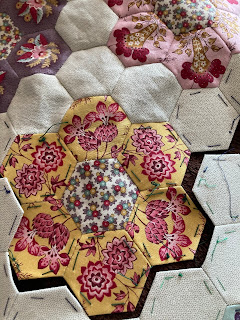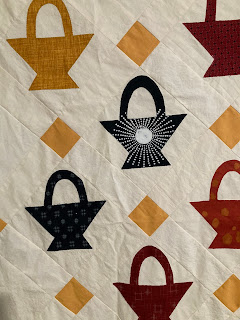Each type of project gets a little different path of production. This post will explain how I look at fusible machine applique (FMA). As much as I love hand applique, this style of quilting holds a special place with me. It was the first, stand alone, workshop I took after learning how to quilt. A few weeks after that class, my phone rang and on the other end was someone from that workshop, asking if I wanted to go on a local shop hop with her. This someone is now very dear to me and we still quilt together 22+ years later. In fact, we will be retreating together in a few weeks.
 |
Old Voices Jeanna Kimball Pattern
|
Once you decide on a pattern the first step is to pull out your light box, pattern, pencils and fusible webbing. I like Steam a Seam Lite. Trace out EVERY piece needed to create the whole quilt. While doing this step try to to maximize your fusible by keep shapes that use the same fabric close together. Each block gets labeled and I draw a line separating the pieces for each block. Now you can put away your fusible and light box and get to the next step.
Pull fabrics for each block and start the fusing process. If your block has cherries, that section of fusible will be cut and fused to a red fabric and set aside. Continue until you have all the pieces of the block fused onto fabric. Take those sections and put in a zip bag. I would continue until I have all the drawings fused onto fabric.
Now you have something that can be done in the evenings, while watching tv. For me, this time is not dedicated "quilting" time, but family time. Put a paper bag on the floor and start cutting out all the shapes. Make sure each piece goes back into its own labeled bag.
Now the only thing you have to do is cut your backgrounds and start designing with your ready to go pieces. Organize your applique pieces on the background and fuse following manufactures directions.
Once you have all your blocks completed, they are ready for the machine applique. For the quilt shown above, it was a perfect retreat project. All the blocks were stacked up, I picked one color of thread, and machine stitched EVERY piece on EVERY block before I changed out my thread color. I see quilters change threads 5 - 6 times for one block, and then move onto the next block. That method is a huge tine sucker. After all the embellishment stitching is completed, you are ready to assemble your quilt top.

For the quilt shown above, I decided to make 1/2 square triangles from all
the colors used in the applique, as well as other fabrics. Each time I
had a fabric out for fusing, I also cut a couple of squares, drew a line
corner to corner and bagged them up. Any time I had light prints on my
cutting table, I cut a few squares for this project and continued to add
to my sashing bag. Don't forget to draw the line before putting them
into a bag. Now I had a "leader/ender" project (Bonnie Hunter system).. It's amazing how fast
these 1/2 squares get sewn together. Every time I get sewing time, I commit to cutting, pressing
and trimming 10 units before I start on my project at the time, and at the end of my sewing time I organize 10 more blocks on my sewing table. That way I have set myself up for my next time at my sewing machine. Once my 1/2 sqs were finished, I again, use the "leader/ender" process to sew the blocks into strips of 6. Also think about Victoria, from VWFQuilts, and her 15 minutes of play. If that's all the time you have to sew, grab this bag and sew a few pieces, or trim up a few pieces. In no time all your sections will be together, and you are on the home stretch of putting the quilt top together.
While working in this method, a lot of time is saved and you might not get burned out at that thought of cutting, marking, sewing, cutting, pressing, and trimming 372 half sq triangles and then sewing them into strips of six. The sections organically get put together while you are moving forward on other projects.
These tips will only be helpful if you work on several projects at one time. I know there are some outliers who start and finish one quilt at a time. Let me know if this has been helpful. I have a few other 'process posts' rolling around and I'd be happy to share.
Meanwhile, keep stitching,
Sharon











































